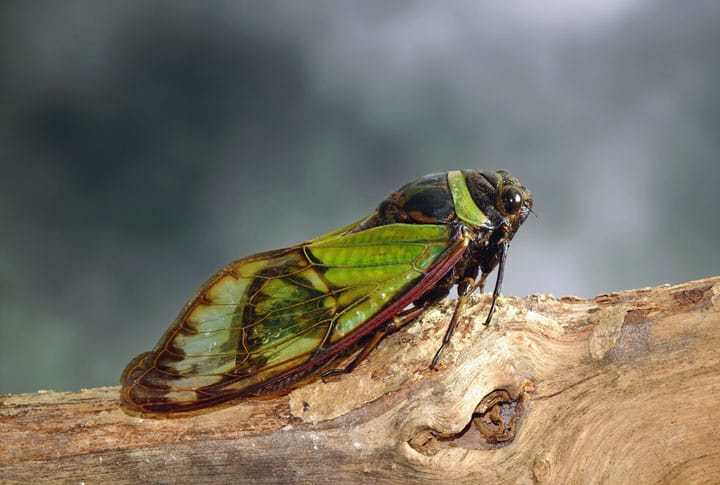Eating cicadas in Thailand
Well before you read on and see the picture, did you know what a cicada is? Not me, but now “I know all about it”. It is one of the many insects eaten in Thailand, straight from nature.
I have previously put an article about the Thai insects on this blog, see www.thailandblog.nl/eten-drinken/insecten-eten-thailand , but the cicada was not mentioned in it.
The cicada
The cicada is an insect of 2 to 5,5 cm with a stocky body, which is usually dark brown or green. The beast looks a bit like a grasshopper. The cicadas family is very large, more than 2500 species have been identified worldwide and I cannot tell you which ones are now caught and eaten in Thailand. A specific characteristic of the cicada is the loud luring sound of the males. That sound can reach up to 120 dB and can be heard at a distance of one and a half kilometers. That sound is caused by vibrating small membranes on both sides of the abdomen. It is a call from the males to the females to mate.
Cicada mating
Cicadas live almost all of their lives underground near plant roots. That life can last for years – sometimes more than 15 years – and in the spring now through April a number emerge en masse, shed their skins, becoming adult cicadas. The males begin their mating song, usually in the heat of the day. After mating, the females will lay their eggs in leaves and twigs. After hatching, the nymphs crawl underground and live there on plant roots.
Source of income
On the website of The Nation I recently read an article about catching cicadas in the southern Thai province of Yala, see: www.nationthailand.com/news/30381241
Because the price of rubber is falling, catching cicadas is seen as an alternative source of income. The report is about a nightly search for cicadas in the Betong district. Residents go out with large searchlights with plastic bags and water bottles. The cicadas come above ground and climb into the trees, where they can then be easily caught with the hands. .
The cicadas are sold to restaurants, among others – the Chinese and Malaysians are very fond of them – and they fetch 2 to 3 baht each alive, and even 5 baht when fried. Cicadas are full of protein and are used in many dishes. A favorite in Betong is the fried cicada in a pepper sauce.
If an entire family goes hunting, an average of between 500 and 1000 cicadas are caught, which still yields 1500 to 2500 baht
Documentary
On the life cycle of the cicada, you can watch a BBC video by Sir David Attenborough below:
https://www.youtube.com/watch?v=tjLiWy2nT7U
Source: The Nation/Wikipedia




Pretty tasty.
Are these perhaps the critters we call crickets?
The sound they make is quite similar.
No, those are crickets, there's not much difference
No crickets are different. Cicadas – Have never eaten them myself. But you never know. Where I am/live now 500km north of Sydney I also have them a lot on my piece of land. Yes ground small by Australian standards, 96 acers. All different types, black - yellow green then red and a little black. Yes, a lot of different beautiful colored insects…
Many times in the past, my kids wore it on their school uniform. Will never forget that.
I did see some years ago that they caught certain insects by smearing sticks with glue.
These insects also made a hell of a racket. I don't know if these are the same
I grew crickets myself for a while, quite nice and quite tasty, sold them per kilo or per 100 grams, good business.
A cricket makes a little more noise than a grasshopper, which 'snorts' more. A cicada, however, gives the tourist the idea that a gigantic electrical machine is being switched on, somewhere high in a tree (crickets live on the ground). It is so loud that it irritates some people. I think it's a magical sound, it starts faltering, stuttering, but after about 15 seconds it starts to vibrate, to sing. It also ends with bumps. Often you only hear 1, and then another somewhere further on, but I once heard 100 at the same time in one place, it drowns everything out. On Koh Chang / Long Beach it starts half an hour before sunrise, at 6 am. That will take 5-7 minutes. around sunset, on the stroke of 6 o'clock, it comes again, also only for a few minutes. They also occur in southern Europe, where they are even larger, up to 4-6 cm. They approach light, and can be caught in this way. If you then stand near a lamp, they can crash into your head completely blinded.
The Thais call them chaka-chaan and when they see one they say yes, can eat..:-)
yes: tjàk-a-tjàn = จักจั่น both syllables low tone with short 'a' sound
(www.slapsystems.nl)
Either way, they make a lot of noise.
Haven't eaten yet, but once ant eggs.
You have to try it once, right? Didn't like it much, but could also be due to the frying fat.
Also fish eggs once in Pathalung. That was certainly disappointing due to the frying, too old oil, I saw right away and was confirmed when consuming.
I do better myself with calf in the Netherlands.
Last week they were in our garden, in a palm tree and yes, in the afternoon, if you walked past them, they made a lot of noise. Our cats had a lot of fun chasing it.